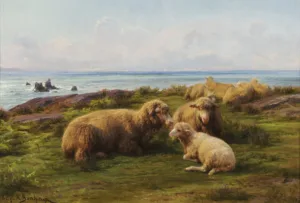Rosa Bonheur: Rosa Bonheur, a name that resonates with artistic brilliance and a trailblazing spirit, remains an iconic figure in the world of art. Born in 1822 in Bordeaux, France, Rosa Bonheur defied societal norms to become one of the most celebrated and influential female artists of the 19th century. While her renowned works, such as “The Horse Fair,” have left an indelible mark on art history, there are several lesser-known facets of her life that add depth to her extraordinary story.

1. Pioneering Cross-Dressing Artist:
One of the most intriguing aspects of Rosa Bonheur’s life was her penchant for cross-dressing. In an era when rigid gender norms constrained women, Bonheur boldly embraced masculine attire, donning trousers and tailored suits. This audacious choice not only defied societal expectations but also allowed her the freedom to navigate the male-dominated art world with a measure of ease. Her unapologetic rejection of traditional gender roles set the stage for future generations of female artists to challenge the status quo.
2. Trailblazer for Women in Art Academia:
At a time when women faced substantial barriers to formal education and entry into artistic institutions, Bonheur’s talent triumphed. She became the first woman to be awarded the prestigious Legion of Honour in France in 1865. Additionally, she received special permission to study animal anatomy at the National Veterinary Institute in Paris, a privilege typically reserved for men. Bonheur’s success opened doors for other aspiring female artists, paving the way for greater inclusivity in art academia.
3. The Horse Fair: A Masterpiece Beyond Its Time:
Rosa Bonheur’s magnum opus, “The Horse Fair,” remains an iconic piece of art that transcends its time. Completed in 1855, this monumental painting captures the raw energy and vitality of a horse market in Paris. What makes this work particularly fascinating is Bonheur’s meticulous attention to detail and her innovative approach to capturing the dynamics of movement and light. “The Horse Fair” remains a testament to Bonheur’s technical prowess and her ability to challenge artistic conventions.

4. International Acclaim and Royal Patronage:
Bonheur’s talent garnered international recognition, and her works were not only coveted by private collectors but also caught the eye of royalty. Queen Victoria of England and Emperor Napoleon III were among her distinguished patrons. Such esteemed endorsements elevated Bonheur’s status and solidified her place as a preeminent artist in 19th-century Europe. Her paintings adorned the walls of palaces and museums, securing her legacy as a truly exceptional artist.
5. Commune of By A Unique Living Experiment:
Rosa Bonheur was not only a visionary artist but also a woman of unconventional lifestyle choices. In 1859, she purchased the Château de By, a 16th-century estate near Fontainebleau Forest. Here, she established a commune of sorts, living with a chosen “family” that included friends, employees, and even her partner, Nathalie Micas. This experimental living arrangement defied societal norms and allowed Bonheur the freedom to pursue her art in a supportive and unconventional environment.
6. A Passion for Animal Rights:
Beyond her artistic pursuits, Rosa Bonheur was a vocal advocate for animal rights. Her deep connection with animals was evident not only in her choice of subjects for paintings but also in her activism. Bonheur ardently opposed animal cruelty and was a member of the Society for the Prevention of Cruelty to Animals. Her commitment to the welfare of animals reflected a compassionate and progressive mindset, aligning her with social causes that extended beyond the realm of art.
7. Legacy and Lasting Influence:
Rosa Bonheur’s impact transcends the boundaries of her lifetime. Her legacy endures through her groundbreaking achievements, challenging of societal norms, and her indomitable spirit. Today, her works are showcased in renowned museums, and her story continues to inspire artists, particularly women, to pursue their passions fearlessly. Bonheur’s life remains a testament to the transformative power of art and the enduring legacy of those who dare to break free from conventional constraints.

Conclusion:
Rosa Bonheur’s life was a tapestry woven with unconventional choices, artistic brilliance, and unwavering determination. Beyond the canvas, she left an indelible mark on the art world, challenging gender norms, advocating for animal rights, and creating timeless masterpieces. As we delve into the untold facets of her life, we gain a deeper appreciation for the woman behind the legendary artist—a pioneer, a trailblazer, and an inspiration for generations to come.
WRITTEN BY ALEX